|
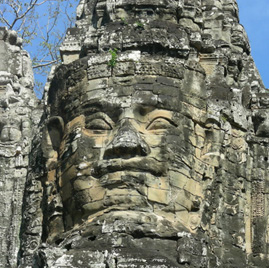
 Karen's Perspective on Traveling Alone Karen's Perspective on Traveling Alone






















|
On the last day before I was going to hike out from the Colorado River to the south rim of the Grand Canyon, I was calming myself down by singing ancient songs to Yemaya. Most of my party of 14 folks whom I had been enjoying the river with for the last week had gone to scout the largest rapid called Hance, classified as a 9 out of a possible 10. It was named for an early river runner and didn't have the iconic names of the largest rapids I had run on the American river over 17 years ago, ones like Meat Grinder and Satan Cesspool, the later the whirlpool of water I had been spit out of when I flipped the inflatable kayak I was on, then swam until my friend Julie picked me up, her eyes as large as saucers. After that spill, I had decided that I didn't really need all the thrills and chills that river rafting afforded, at least not on the American River.
But here I was experiencing that same mixture of dread and excitement, waiting for the oarspeople and especially my cousin Jeff to return with his verdict. I had chosen not to scout the rapid as avoiding seeing the enormous hole we would likely have to plunge into seemed the preferable option. After perhaps 15 minutes my party returned. Jeff announced that there seemed to be no option to avoid the hole. His wife and trip leader Jan agreed that we would all paddle forward and then as we reached the hole, hang on. Jan asked me to start singing again as a way no doubt to calm all our nerves. Ours was the first of 5 boats that would attempt the rapid and we would wait downstream in case we needed to rescue anyone else. We paddled forward, then we were in the rushing water, seemingly coming from every possible direction and now I saw the hole, with the 15 feet or so drop. The force of the water turned the boat upward on its pontoon a bit and I hung on for dear life with one foot wedged into the steel of the frame. Before I knew it my other leg was pushed over the pontoon it had been draping on but Jeff soon righted the boat and we were clear!
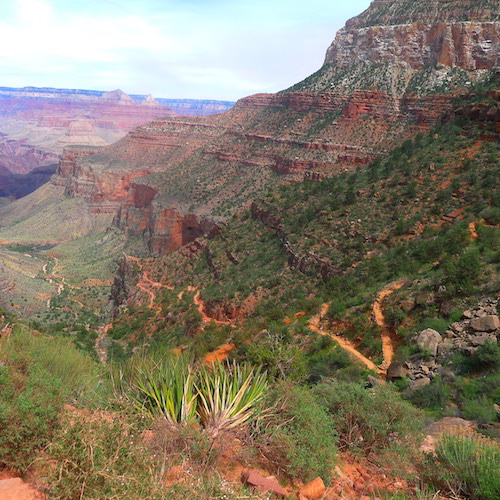 Our party of 14 had launched on March 29th after a day spent at Lee's Ferry rigging all the gear onto 3 "cat" boats (made out of lightweight aluminum and steel and 2 pumped up pontoons, forming a secure but highly navigable catamaran.) The other 2 boats were small wooden ones called "dories" designed by owners Lincoln and his daughter Iris who had designed and built her boat at age 19. The dory is a small, shallow-draft boat, around 15 feet long with high sides, a flat bottom and sharp bows. They are more work to steer as they are not self-bailing so the passengers are constantly bailing during the rapids. Later that day, Lincoln's boat hit a rock, causing a gash in the wood of about 2 feet that had to be patched so we could continue down the river and get to a campsite. The plan was to dry out the boat and do a more secure patch on a layover day.
Our party of 14 had launched on March 29th after a day spent at Lee's Ferry rigging all the gear onto 3 "cat" boats (made out of lightweight aluminum and steel and 2 pumped up pontoons, forming a secure but highly navigable catamaran.) The other 2 boats were small wooden ones called "dories" designed by owners Lincoln and his daughter Iris who had designed and built her boat at age 19. The dory is a small, shallow-draft boat, around 15 feet long with high sides, a flat bottom and sharp bows. They are more work to steer as they are not self-bailing so the passengers are constantly bailing during the rapids. Later that day, Lincoln's boat hit a rock, causing a gash in the wood of about 2 feet that had to be patched so we could continue down the river and get to a campsite. The plan was to dry out the boat and do a more secure patch on a layover day.
The night we camped at Lee's Ferry before leaving had been a windy one, with gusts of wind blowing my tent around and leaving a thin layer of sand everywhere, including in my teeth when I went for a drink of water during the night. The next day, the park ranger checked all of our gear, making sure that we had all the required paraphanalia including regulation life jackets, kitchen gear, propane tanks and most importantly, the steel canisters for our human waste, affectionately known as the "groovers." We also had a satellite phone for emergencies and texts, unbelievable amounts of gourmet food in coolers with ice and incredible stores of beer and wine in pouches.
Jan had applied for this permit every year for 10 years and I was lucky enough to tag along. Incredible logistics go into planning a Grand Canyon expedition and my cousins and friends were doing it in the cheapest and most time honored way. Our group had been divided into teams of cooks with daily chores. Only two parties a day can launch from Lee's Ferry and the other party had rented all their equipment and organized food from an "outfitter." Both parties had hired folks to shuttle the cars to the end at the takeout, over 230 miles away.
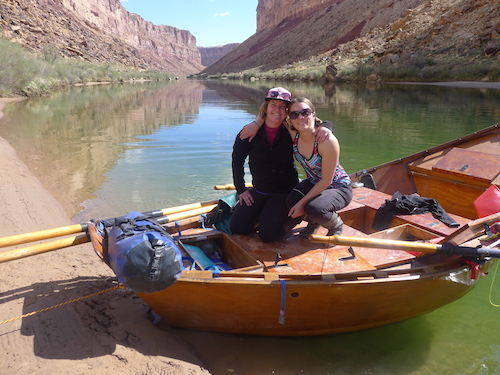 For the first day, I shared a boat with Jesse, a 30 something "boatman" who had trained as a guide with Jeff and was an electrician as well as being the boyfriend of Wonderwoman Iris. Jesse was fit and lean and although he had never been to the Grand Canyon before, he seemed confident and eager to be on our way. The water was remarkably clear and a crisp 46 degrees. I had on a neoprene layer plus splash jacket and pants, wool socks, neoprene booties and gloves. I was barely warm enough though under the cloudy sky. We started off in what's called The Marble Canyon and around every turn was a remarkable new vista and sometimes whole new kinds of rock formations. Merganser ducks and an osprey were visible in the first few minutes from shore. I had read Wallace Stegner's Beyond the Hundredth Meridian, about Major John Wesley Powell's successful expedition on these same waters in 1869. Our boats were so much more steady and lightweight, our provisions more gourmet and nutritious but I think we all experienced the same heightened sense of adventure and appreciation for the majesty of the canyon. We knew the river's course and hoped the park service would come to our rescue via a helicopter if we really got into trouble. But the trip was still a strenuous one and not for the faint hearted.
For the first day, I shared a boat with Jesse, a 30 something "boatman" who had trained as a guide with Jeff and was an electrician as well as being the boyfriend of Wonderwoman Iris. Jesse was fit and lean and although he had never been to the Grand Canyon before, he seemed confident and eager to be on our way. The water was remarkably clear and a crisp 46 degrees. I had on a neoprene layer plus splash jacket and pants, wool socks, neoprene booties and gloves. I was barely warm enough though under the cloudy sky. We started off in what's called The Marble Canyon and around every turn was a remarkable new vista and sometimes whole new kinds of rock formations. Merganser ducks and an osprey were visible in the first few minutes from shore. I had read Wallace Stegner's Beyond the Hundredth Meridian, about Major John Wesley Powell's successful expedition on these same waters in 1869. Our boats were so much more steady and lightweight, our provisions more gourmet and nutritious but I think we all experienced the same heightened sense of adventure and appreciation for the majesty of the canyon. We knew the river's course and hoped the park service would come to our rescue via a helicopter if we really got into trouble. But the trip was still a strenuous one and not for the faint hearted.
At our first lunch stop we lucked out and saw 5 or 6 California condors, a propitious sign for our journey. They circled high overhead but with my good binocs I could see the white of their feather tips. Already the trip was exceeding my expectations. Everyday we heard the call of the canyon wren, a series of descending notes that became as ubiquitous as the low cooing of the mourning dove in West Texas, where I grew up. I'm not entirely sure I ever saw the canyon wren but other sightings included a black crowned night heron, numerous blue herons, a couple of red tailed hawks and possibly a peregrine falcon or perhaps it was a red-tailed hawk.
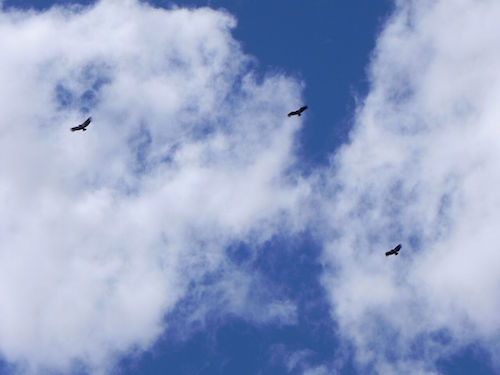 I was on cooking duty the first 3 days with Kristeen and our meals included salmon steaks and asparagus that I grilled over charcoal in the "fire stand" we brought where we also made a wood fire with wood we had brought and foraged driftwood. The second night we made a hearty minestrone which was welcome for the cool night. Lincoln played the dobro and Rob joined him on the guitar while Mattie brought along her ukulele. I joined for some songs, especially for Lovesick Blues, as that was a childhood favorite of my Dad's. We of course had brought comfortable camp chairs and enjoyed the camaraderie of a day well spent, reliving the most memorable adventures and sights. I slept on a thermarest pad but everyone else seemed to have paco pads, a big but fairly lightweight pad that could get wet on the boat.
I was on cooking duty the first 3 days with Kristeen and our meals included salmon steaks and asparagus that I grilled over charcoal in the "fire stand" we brought where we also made a wood fire with wood we had brought and foraged driftwood. The second night we made a hearty minestrone which was welcome for the cool night. Lincoln played the dobro and Rob joined him on the guitar while Mattie brought along her ukulele. I joined for some songs, especially for Lovesick Blues, as that was a childhood favorite of my Dad's. We of course had brought comfortable camp chairs and enjoyed the camaraderie of a day well spent, reliving the most memorable adventures and sights. I slept on a thermarest pad but everyone else seemed to have paco pads, a big but fairly lightweight pad that could get wet on the boat.
After camping above Soap Creek on day 1, we hit the rapid House Rock where Jeff scared the group with a tilt toward a flip. We noted the enormous boulder in the middle of the channel with logs on top of the rock up 15 or 20 feet, almost unbelievably deposited there in the 1957 flood and a warning about the power of the water. Now though, the water was dam released at the Glen Canyon dam upriver so the flow was fairly stable, although there were low and high tides each day.
Throughout the week we would make and break camp each night and then awake by 6:30am to start the routine all over. Everyone chose their own campsite every night and I made sure to place mine faraway from the communal kitchen and with a great view of the river and stars. Some nights we camped with the rush of the river invading our dreams of the rapids to come while some nights we camped at an edy with the soft murmur of a gentle flow. But all days were reduced to rock, sand, sky, sun and mostly water, the ever present water, so sublime and ever changing. From our campsites and hikes I spotted the pale primrose and later orange mallow, light lavender daises and gorgeous redbud trees just blooming out.
 Day 2 was the coldest and most difficult of the trip as we ran rapid after rapid of the "roaring twenties," from mile 20-30. We would dry out only to get splashed by the "wavy train" of the next series of rapids. After arriving at camp those of us chilled to the bone dropped our clothes as soon as we could, reveling in the warm and dry clothes before setting up camp. On Day 3 we enjoyed a mellow paddle to Redwall Cavern, a massive overhang that John Wesley Powell thought could hold 50,000 people. He was exaggerating but the scale was impressive. We posed for photos before continuing on past the Navajo Bridge, one of only two bridges that span the Colorado, before passing by Varsey's Paradise, an oasis with maiden ferns named for the botanist who accompanied Powell on his second Grand Canyon voyage.
Day 2 was the coldest and most difficult of the trip as we ran rapid after rapid of the "roaring twenties," from mile 20-30. We would dry out only to get splashed by the "wavy train" of the next series of rapids. After arriving at camp those of us chilled to the bone dropped our clothes as soon as we could, reveling in the warm and dry clothes before setting up camp. On Day 3 we enjoyed a mellow paddle to Redwall Cavern, a massive overhang that John Wesley Powell thought could hold 50,000 people. He was exaggerating but the scale was impressive. We posed for photos before continuing on past the Navajo Bridge, one of only two bridges that span the Colorado, before passing by Varsey's Paradise, an oasis with maiden ferns named for the botanist who accompanied Powell on his second Grand Canyon voyage.
Day 5 began with a remarkable sighting in my campsite, a huge stag munching away on the luxurious grass and spring plants. We had lunch at Saddle Canyon where we took a hike up the side canyon and saw a small waterfall. Red buds were in the canyon as well as the ever present barberry, a holly-like plant. We watched the "youngsters" play Ladderball on the beach, a game that consisted of throwing balls with attached strings onto 2 foot ladders placed around 30 feet away. The sun was out and Jan and I took solar showers, holding the bag for the other as we washed away the grime and sand of 3 days, then putting on clean clothes. We camped at Nankoweep and as Jan and I were not on cooking duty, we headed with the "youngsters" to hike up around 2 miles for the stunning long view of the canyon and watched its colors fade and change with the light reflecting off the surface. We walked a short ways to visit another group camped downriver, mainly to find out where they planned to camp the next night but they weren't especially receptive. We headed back at dusk for another delicious meal, this one included pasta with garlic bread.
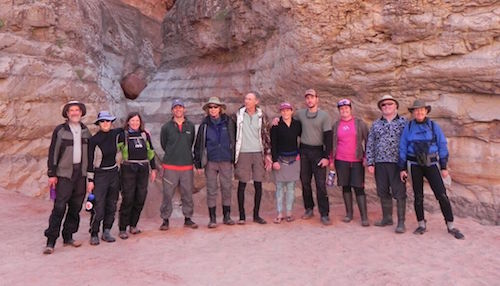 One of the most stunning views of the entire trip was seeing the confluence of the Colorado River with the Little Colorado River, one of 2 large tributaries that flow into the Colorado. The Little Colorado was a shocking and gorgeous travertine color compared to the emerald color of the Colorado and at possibly 10 degrees warmer.
One of the most stunning views of the entire trip was seeing the confluence of the Colorado River with the Little Colorado River, one of 2 large tributaries that flow into the Colorado. The Little Colorado was a shocking and gorgeous travertine color compared to the emerald color of the Colorado and at possibly 10 degrees warmer.
The Powell Geographic Expedition, on August 10, 1869, was one of the first American parties to sight the Little Colorado River. Powell and some of his crew explored a segment of the Little Colorado River canyon, although they mainly found it impassable. In diary entries, they recorded its name as "Flax River", for the flax that makes up much of the river's riparian zone-and "Colorado Chiquito"-so, presumably they already knew about the river before they had come on the expedition.
It is a lo[a]thesome little stream, so filthy and muddy that it fairly stinks. It is only 30 to 50 [yards] wide now and in many places a man can cross it on the rocks without going on to his knees ... [The Little Colorado was] as disgusting a stream as there is on the continent ... half of its volume and 2/3 of its weight is mud and silt. [It was little but] slime and salt ... a miserably lonely place indeed, with no signs of life but lizards, bats and scorpions. It seemed like the first gates of hell. One almost expected to see Cerberus poke his ugly head out of some dismal hole and growl his disapproval of all who had not Charon's pass. -George Bradley and Jack Sumner, August 1869
This was in fact an inaccurate depiction of the Little Colorado, as the muddy flow they observed was the result of a rare flash flood. Lucky for us, there has been no flooding and the color of the river cheered our party as we explored a bit upstream. The spectacular area is a proposed site by a Scottsdale developer and includes a 1.4-mile tramway that would shuttle up to 10,000 visitors a day to the bottom of the Grand Canyon. It would also feature an elevated walkway and amphitheater below the rim, as well as a hotel, restaurant, RV center, and other resort attractions above the rim. The entire area is sacred to Navajo, Hopi, Zuni, and other native people of the Grand Canyon region. For river runners and millions of other citizens, the development "would desecrate one of the country's most beloved wilderness shrines."
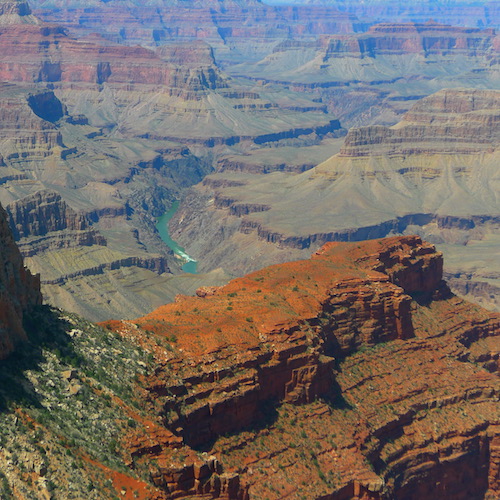 On this day we noted two solo backpackers along the river, one sitting in a chair, along with kayakers who were practicing their rolls. Fauna sightings included the distinctive Abert squirrel, recognisable by its tufted ears, gray color and its love of the seeds and cones of the ponderosa pine. We took a fascinating hike to a Native American birthing chair, with intricate designs drawn on its side and a gorgeous view high up of the river. Several of us had our photos taken here but no one seemed to know which tribe might have fashioned it. There seems to be no information online so I will let the mystery be. Today was the start of seeing the Bright Angel shale, a variation that I learned to recognize, especially on my hike up the canyon. We also started to see my favorite rocks of the canyon, the polished black varnish of the visnu schist against the stunning pink of the zoraster granite.
On this day we noted two solo backpackers along the river, one sitting in a chair, along with kayakers who were practicing their rolls. Fauna sightings included the distinctive Abert squirrel, recognisable by its tufted ears, gray color and its love of the seeds and cones of the ponderosa pine. We took a fascinating hike to a Native American birthing chair, with intricate designs drawn on its side and a gorgeous view high up of the river. Several of us had our photos taken here but no one seemed to know which tribe might have fashioned it. There seems to be no information online so I will let the mystery be. Today was the start of seeing the Bright Angel shale, a variation that I learned to recognize, especially on my hike up the canyon. We also started to see my favorite rocks of the canyon, the polished black varnish of the visnu schist against the stunning pink of the zoraster granite.
Day 6th was the passage through the thrilling Hanze rapid and we celebrated our triumph through the rapid plus the birthday of 27 year old Iris, complete with a romp of Richard Simmons and Jazzercise. The youngsters were adorable in their well executed Jazzercise costumes and I led them through some improvised routines, using a paddle as my prop. Jeff and Jan grilled pork chops on the grill and even made a pound cake in the Dutch oven by carefully placing hot coals above and below the sturdy pan to bake it through. We had chocolate icing which I placed on top like the canyon structure itself with a river snaking through it. We were camped at Lower Cremation and I left off the fly to my tent so I could take in the immensity of the stars. It was my last night in the bottom of the canyon and now the days and nights seemed to have flown by too fast. I wanted to savor the night but I also knew I needed my sleep so I could climb out the next day.
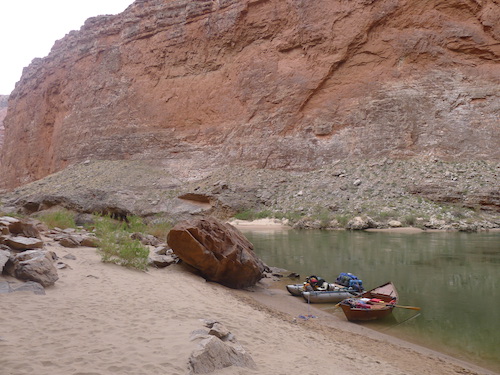 Day 7th I was awakened at 6am with Jan apologizing for the early wake up call. Our party was making the exchange of passengers today and we needed an early start, especially so we would have plenty of time for the 7.5 mile ascent from Pipe Creek up the Bright Angel Trail to the south rim, passing famed Phantom Ranch and the 2nd bridge over the river. It was a tearful goodbye for me with Jeff and Jan as it marked the end of that remarkable week when I had been both swaddled and tumbled by the river. Time compresses and conflates any trip. I know I was rafting on the water for 3-5 hours a day but when I think back on the time, especially in the context of the geologic time of the canyon, it was less than the blink of an eye. I see now that one really does need 23 days on the river, to experience a lasting impression of its time outside time. Powell's trip took around 3 months to traverse the route my Team Hester was taking less than a month to complete.
Day 7th I was awakened at 6am with Jan apologizing for the early wake up call. Our party was making the exchange of passengers today and we needed an early start, especially so we would have plenty of time for the 7.5 mile ascent from Pipe Creek up the Bright Angel Trail to the south rim, passing famed Phantom Ranch and the 2nd bridge over the river. It was a tearful goodbye for me with Jeff and Jan as it marked the end of that remarkable week when I had been both swaddled and tumbled by the river. Time compresses and conflates any trip. I know I was rafting on the water for 3-5 hours a day but when I think back on the time, especially in the context of the geologic time of the canyon, it was less than the blink of an eye. I see now that one really does need 23 days on the river, to experience a lasting impression of its time outside time. Powell's trip took around 3 months to traverse the route my Team Hester was taking less than a month to complete.
I was eager to get on the trail as this was the part of the trip I had most anticipated. I had my broken in boots, my poles and a liter and a half of water. I also had my ipod if I needed that last bit of Latin music to get me up the steep ascent. The trail to Indian Gardens, a lovely riparian campsite, was less than 3 miles and I arrived more quickly and with more water than I had imagined. I enjoyed seeing the mule train at rest and had a snack before starting up again. I had been walking along Pipe Creek for most of the way, appreciating its stunning canyons of zoraster granite and vishnu schist before morphing into the Bright Angel shale, more common the higher elevation. Backpackers with overnight gear passed me coming and going. Redbuds had given way to nopal cactuses with gorgeous vistas as far as the eye could see. I stopped frequently to admire the ever changing colors, catch my breath and drink more water. The trail work was a marvel here with incredibly steep switchbacks. I arrived at the first rest house and knew I still had 3.5 miles to the top. The trail seemed to get even steeper or perhaps it was the altitude. But unlike the hike in Peru to Colca Canyon I had done 6 months earlier, there was more shade and I felt stronger. I continued to stop at closer and closer intervals, especially after resting at the resthouse, only 1.5 miles from the rim. I made it to the top, after 7 hours, averaging a little more than a mile an hour, a new personal slowest record!
I checked into the Bright Angel Lodge and was delighted to find out I could use the shared bathroom with a delicious bath. I called my dad and he was relieved to hear from me as he, uncharacteristically, had been a bit worried. He and my sister had climbed both down and up the canyon when he was 59, only spending one night at the bottom. I couldn't imagine doing that and assured him I was fine if tired. I enjoyed the crisp and clean clothes one of my companions had in her car as I had shipped some clean clothes to await my arrival. Almost never had a bed felt so comfortable and I slept 11 hours. I rented a bike the next day and cycled 10 miles to Hermit's Rest, designed by Mary Colter whose biography I had skimmed earlier that day in the History Room at the lodge. She was never married and seemed to be a lesbian, with a resume somewhat similar to architect Julia Morgan. After coming home, I checked the internet and, of course, Adrienne Rich had surmised the same conclusion and made this observation "Colter's lifework-a remarkable accomplishment for a woman architect-was thus inextricable from the violation and exploitation of native culture by white entrepreneurs. Yet her love for that culture was lifelong."
I ended my trip by seeing a rose-breasted grosbeak from the balcony outside my room at the Maswick Lodge, two elk near the train station and a peregrine falcon diving quickly from the rim near Hermit's Rest. I took the shuttle to Flagstaff and marveled at the still visible snowpack all over the Sierra as I flew home.
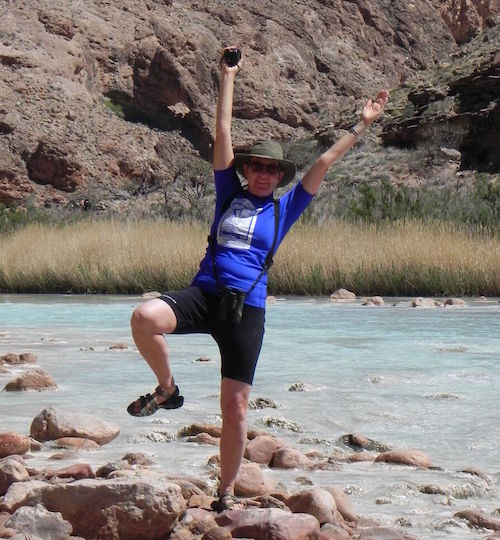
|
|



 Karen's Perspective on Traveling Alone
Karen's Perspective on Traveling Alone


 Karen's Perspective on Traveling Alone
Karen's Perspective on Traveling Alone